应用行为分析法( Applied Behavior Analysis )
- 格式:ppt
- 大小:8.27 MB
- 文档页数:139
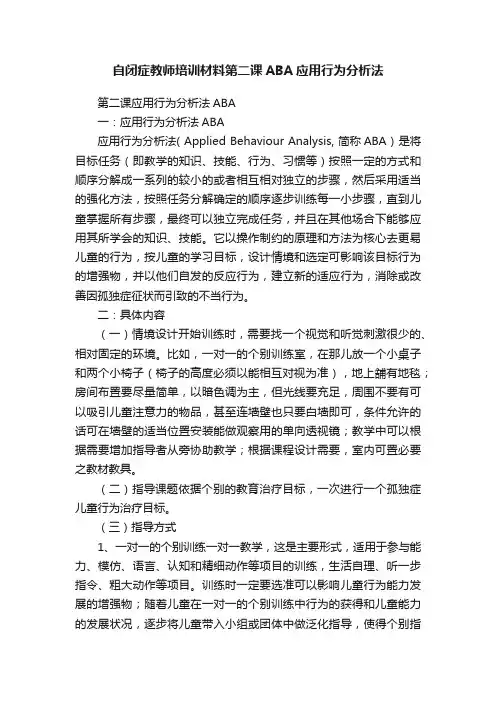
自闭症教师培训材料第二课ABA应用行为分析法第二课应用行为分析法ABA一:应用行为分析法ABA应用行为分析法( Applied Behaviour Analysis, 简称ABA ) 是将目标任务(即教学的知识、技能、行为、习惯等)按照一定的方式和顺序分解成一系列的较小的或者相互相对独立的步骤,然后采用适当的强化方法,按照任务分解确定的顺序逐步训练每一小步骤,直到儿童掌握所有步骤,最终可以独立完成任务,并且在其他场合下能够应用其所学会的知识、技能。
它以操作制约的原理和方法为核心去更易儿童的行为,按儿童的学习目标,设计情境和选定可影响该目标行为的增强物,并以他们自发的反应行为,建立新的适应行为,消除或改善因孤独症征状而引致的不当行为。
二:具体内容(一)情境设计开始训练时,需要找一个视觉和听觉刺激很少的、相对固定的环境。
比如,一对一的个别训练室,在那儿放一个小桌子和两个小椅子(椅子的高度必须以能相互对视为准),地上舖有地毯;房间布置要尽量简单,以暗色调为主,但光线要充足,周围不要有可以吸引儿童注意力的物品,甚至连墙壁也只要白墙即可,条件允许的话可在墙壁的适当位置安装能做观察用的单向透视镜;教学中可以根据需要增加指导者从旁协助教学;根据课程设计需要,室内可置必要之教材教具。
(二)指导课题依据个别的教育治疗目标,一次进行一个孤独症儿童行为治疗目标。
(三)指导方式1、一对一的个别训练一对一教学,这是主要形式,适用于参与能力、模仿、语言、认知和精细动作等项目的训练,生活自理、听一步指令、粗大动作等项目。
训练时一定要选准可以影响儿童行为能力发展的增强物;随着儿童在一对一的个别训练中行为的获得和儿童能力的发展状况,逐步将儿童带入小组或团体中做泛化指导,使得个别指导中所习得的行为得以在团体或生活实际中发展。
2、以活动为基础的教学,这适用于教儿童同他人游戏、交往、语言理解和语言表达等项目。
3、偶发事件中的教学,在生活(家庭、社会等)中,尤其是社会交往、社会适应等活动,抓住机会促使儿童运用已会的知识、技能和展示已养成的行为、习惯;抓住机会自然地教给儿童知识、技能、培养儿童良好的行为、习惯。
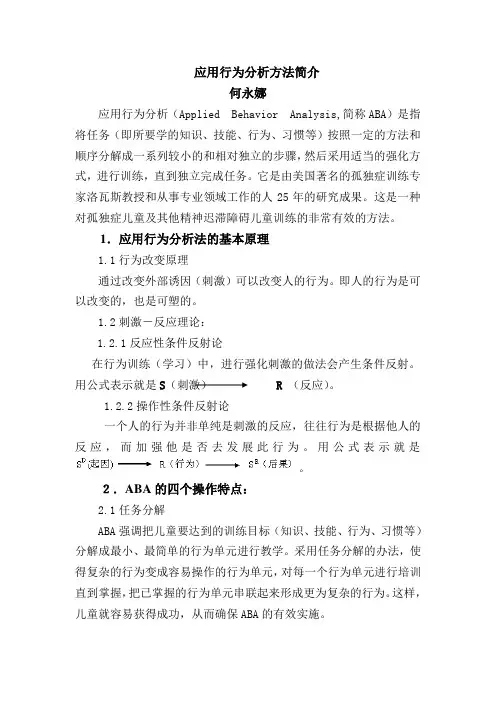
应用行为分析方法简介何永娜应用行为分析(Applied Behavior Analysis,简称ABA)是指将任务(即所要学的知识、技能、行为、习惯等)按照一定的方法和顺序分解成一系列较小的和相对独立的步骤,然后采用适当的强化方式,进行训练,直到独立完成任务。
它是由美国著名的孤独症训练专家洛瓦斯教授和从事专业领域工作的人25年的研究成果。
这是一种对孤独症儿童及其他精神迟滞障碍儿童训练的非常有效的方法。
1.应用行为分析法的基本原理1.1行为改变原理通过改变外部诱因(刺激)可以改变人的行为。
即人的行为是可以改变的,也是可塑的。
1.2刺激-反应理论:1.2.1反应性条件反射论在行为训练(学习)中,进行强化刺激的做法会产生条件反射。
用公式表示就是S(刺激)R (反应)。
1.2.2操作性条件反射论一个人的行为并非单纯是刺激的反应,往往行为是根据他人的反应,而加强他是否去发展此行为。
用公式表示就是。
2.ABA的四个操作特点:2.1任务分解ABA强调把儿童要达到的训练目标(知识、技能、行为、习惯等)分解成最小、最简单的行为单元进行教学。
采用任务分解的办法,使得复杂的行为变成容易操作的行为单元,对每一个行为单元进行培训直到掌握,把已掌握的行为单元串联起来形成更为复杂的行为。
这样,儿童就容易获得成功,从而确保ABA的有效实施。
2.2给予辅助为了促使儿童对指令作出正确的反应,给予必要的提示帮助。
普通儿童可以通过观察模仿学习,而孤独症儿童很少去主动观察模仿,所以必需给他们以提示,给他们多次的机会对指令作出反应。
并通过反复的练习促使儿童成功,以后逐渐减少对儿童的提示,直到无需提示儿童也能正确做出反应。
2.3及时强化ABA强调任何一种行为变化都和它自身的结果有关联。
及时有效的强化可以让儿童更愿意配合,更喜欢训练,儿童帮助树立自信心。
2.4反复练习因为使用了强化和提示,儿童才愿意反复进行练习。
反复进行练习,帮助儿童更快、更好地掌握和熟练技能。
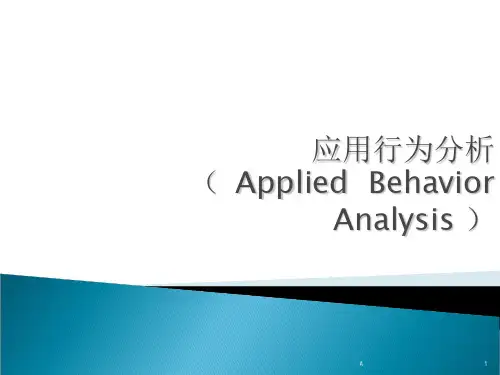
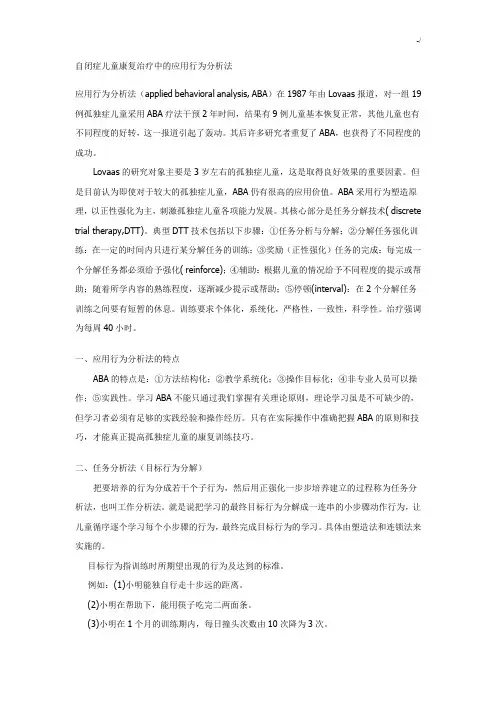
自闭症儿童康复治疗中的应用行为分析法应用行为分析法(applied behavioral analysis, ABA)在1987年由Lovaas报道,对一组19例孤独症儿童采用ABA疗法干预2年时间,结果有9例儿童基本恢复正常,其他儿童也有不同程度的好转,这一报道引起了轰动。
其后许多研究者重复了ABA,也获得了不同程度的成功。
Lovaas的研究对象主要是3岁左右的孤独症儿童,这是取得良好效果的重要因素。
但是目前认为即使对于较大的孤独症儿童,ABA仍有很高的应用价值。
ABA采用行为塑造原理,以正性强化为主,刺激孤独症儿童各项能力发展。
其核心部分是任务分解技术( discrete trial therapy,DTT)。
典型DTT技术包括以下步骤:①任务分析与分解;②分解任务强化训练:在一定的时间内只进行某分解任务的训练;③奖励(正性强化)任务的完成:每完成一个分解任务都必须给予强化( reinforce);④辅助:根据儿童的情况给予不同程度的提示或帮助;随着所学内容的熟练程度,逐渐减少提示或帮助;⑤停顿(interval):在2个分解任务训练之间要有短暂的休息。
训练要求个体化,系统化,严格性,一致性,科学性。
治疗强调为每周40小时。
一、应用行为分析法的特点ABA的特点是:①方法结构化;②教学系统化;③操作目标化;④非专业人员可以操作;⑤实践性。
学习ABA不能只通过我们掌握有关理论原则,理论学习虽是不可缺少的,但学习者必须有足够的实践经验和操作经历。
只有在实际操作中准确把握ABA的原则和技巧,才能真正提高孤独症儿童的康复训练技巧。
二、任务分析法(目标行为分解)把要培养的行为分成若干个子行为,然后用正强化一步步培养建立的过程称为任务分析法,也叫工作分析法。
就是说把学习的最终目标行为分解成一连串的小步骤动作行为,让儿童循序逐个学习每个小步骤的行为,最终完成目标行为的学习。
具体由塑造法和连锁法来实施的。
目标行为指训练时所期望出现的行为及达到的标准。
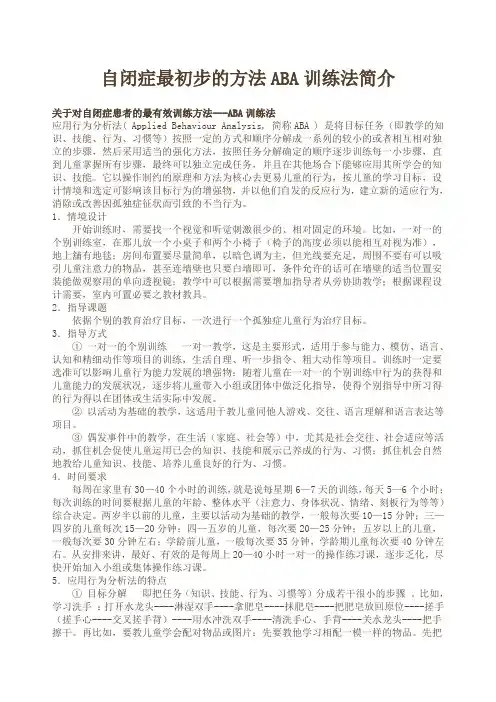
自闭症最初步的方法ABA训练法简介关于对自闭症患者的最有效训练方法---ABA训练法应用行为分析法( Applied Behaviour Analysis, 简称ABA ) 是将目标任务(即教学的知识、技能、行为、习惯等)按照一定的方式和顺序分解成一系列的较小的或者相互相对独立的步骤,然后采用适当的强化方法,按照任务分解确定的顺序逐步训练每一小步骤,直到儿童掌握所有步骤,最终可以独立完成任务,并且在其他场合下能够应用其所学会的知识、技能。
它以操作制约的原理和方法为核心去更易儿童的行为,按儿童的学习目标,设计情境和选定可影响该目标行为的增强物,并以他们自发的反应行为,建立新的适应行为,消除或改善因孤独症征状而引致的不当行为。
1.情境设计开始训练时,需要找一个视觉和听觉刺激很少的、相对固定的环境。
比如,一对一的个别训练室,在那儿放一个小桌子和两个小椅子(椅子的高度必须以能相互对视为准),地上舖有地毯;房间布置要尽量简单,以暗色调为主,但光线要充足,周围不要有可以吸引儿童注意力的物品,甚至连墙壁也只要白墙即可,条件允许的话可在墙壁的适当位置安装能做观察用的单向透视镜;教学中可以根据需要增加指导者从旁协助教学;根据课程设计需要,室内可置必要之教材教具。
2.指导课题依据个别的教育治疗目标,一次进行一个孤独症儿童行为治疗目标。
3.指导方式①一对一的个别训练一对一教学,这是主要形式,适用于参与能力、模仿、语言、认知和精细动作等项目的训练,生活自理、听一步指令、粗大动作等项目。
训练时一定要选准可以影响儿童行为能力发展的增强物;随着儿童在一对一的个别训练中行为的获得和儿童能力的发展状况,逐步将儿童带入小组或团体中做泛化指导,使得个别指导中所习得的行为得以在团体或生活实际中发展。
②以活动为基础的教学,这适用于教儿童同他人游戏、交往、语言理解和语言表达等项目。
③偶发事件中的教学,在生活(家庭、社会等)中,尤其是社会交往、社会适应等活动,抓住机会促使儿童运用已会的知识、技能和展示已养成的行为、习惯;抓住机会自然地教给儿童知识、技能、培养儿童良好的行为、习惯。
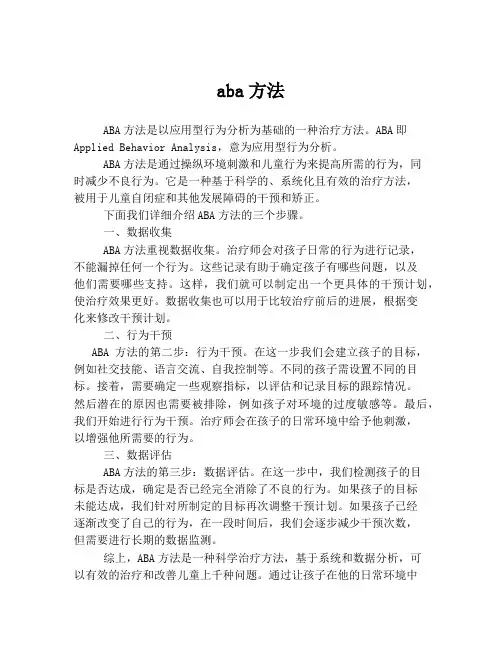
aba方法ABA方法是以应用型行为分析为基础的一种治疗方法。
ABA即Applied Behavior Analysis,意为应用型行为分析。
ABA方法是通过操纵环境刺激和儿童行为来提高所需的行为,同时减少不良行为。
它是一种基于科学的、系统化且有效的治疗方法,被用于儿童自闭症和其他发展障碍的干预和矫正。
下面我们详细介绍ABA方法的三个步骤。
一、数据收集ABA方法重视数据收集。
治疗师会对孩子日常的行为进行记录,不能漏掉任何一个行为。
这些记录有助于确定孩子有哪些问题,以及他们需要哪些支持。
这样,我们就可以制定出一个更具体的干预计划,使治疗效果更好。
数据收集也可以用于比较治疗前后的进展,根据变化来修改干预计划。
二、行为干预ABA方法的第二步:行为干预。
在这一步我们会建立孩子的目标,例如社交技能、语言交流、自我控制等。
不同的孩子需设置不同的目标。
接着,需要确定一些观察指标,以评估和记录目标的跟踪情况。
然后潜在的原因也需要被排除,例如孩子对环境的过度敏感等。
最后,我们开始进行行为干预。
治疗师会在孩子的日常环境中给予他刺激,以增强他所需要的行为。
三、数据评估ABA方法的第三步:数据评估。
在这一步中,我们检测孩子的目标是否达成,确定是否已经完全消除了不良的行为。
如果孩子的目标未能达成,我们针对所制定的目标再次调整干预计划。
如果孩子已经逐渐改变了自己的行为,在一段时间后,我们会逐步减少干预次数,但需要进行长期的数据监测。
综上,ABA方法是一种科学治疗方法,基于系统和数据分析,可以有效的治疗和改善儿童上千种问题。
通过让孩子在他的日常环境中经历不同的体验,我们可以帮助孩子逐渐掌握更有益的行为,逐步实现自我成长,使孩子与家人、朋友和社区更好地互动。
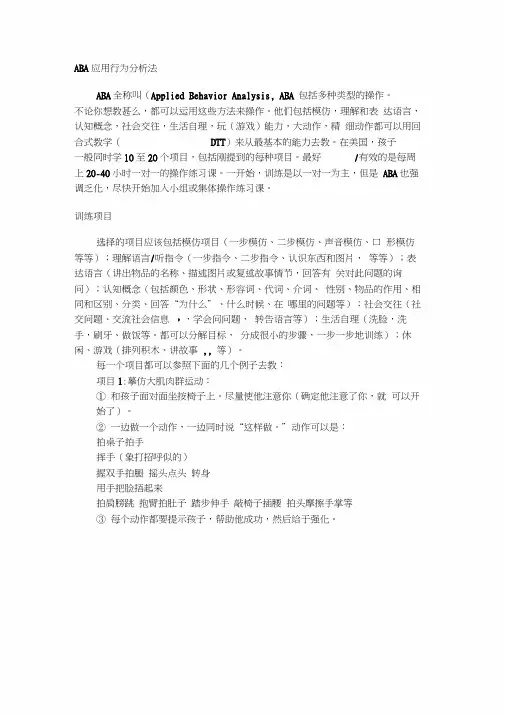
ABA应用行为分析法ABA全称叫(Applied Behavior Analysis, ABA 包括多种类型的操作。
不论你想教甚么,都可以运用这些方法来操作。
他们包括模仿,理解和表达语言,认知概念,社会交往,生活自理,玩(游戏)能力,大动作,精细动作都可以用回合式教学(DTT)来从最基本的能力去教。
在美国,孩子一般同时学10至20个项目,包括刚提到的每种项目。
最好/有效的是每周上20-40小时一对一的操作练习课。
一开始,训练是以一对一为主,但是ABA也强调乏化,尽快开始加入小组或集体操作练习课。
训练项目选择的项目应该包括模仿项目(一步模仿、二步模仿、声音模仿、口形模仿等等);理解语言/听指令(一步指令、二步指令、认识东西和图片,等等);表达语言(讲出物品的名称、描述图片或复述故事情节,回答有关对此问题的询问);认知概念(包括颜色、形状、形容词、代词、介词、性别、物品的作用、相同和区别、分类、回答“为什么”、什么时候、在哪里的问题等);社会交往(社交问题、交流社会信息,,学会问问题,转告语言等);生活自理(洗脸,洗手,刷牙、做饭等。
都可以分解目标,分成很小的步骤,一步一步地训练);休闲、游戏(排列积木、讲故事,, 等)。
每一个项目都可以参照下面的几个例子去教:项目1:摹仿大肌肉群运动:①和孩子面对面坐按椅子上。
尽量使他注意你(确定他注意了你,就可以开始了)。
②一边做一个动作,一边同时说“这样做。
”动作可以是:拍桌子拍手挥手(象打招呼似的)握双手拍腿摇头点头转身用手把脸捂起来拍肩膀跳抱臂拍肚子踏步伸手敲椅子插腰拍头摩擦手掌等③每个动作都要提示孩子,帮助他成功,然后给于强化。
④逐渐地减少实践的提示,改变强化方式。
减少提示,加强表扬获奖励。
最后孩子能够按照指令反应正确时才给他强化。
项目2 :摹仿口形的运动:①和孩子对面坐好。
确定他是否注意。
②边示范边说:“这样做。
”口型动作包括:张嘴伸舌头噘嘴磕牙齿吹的动作笑吻舌头抵上下牙齿等注意:你的目的是什么?如果是要求语音模仿,那么一边做动作,一边要发出声响。
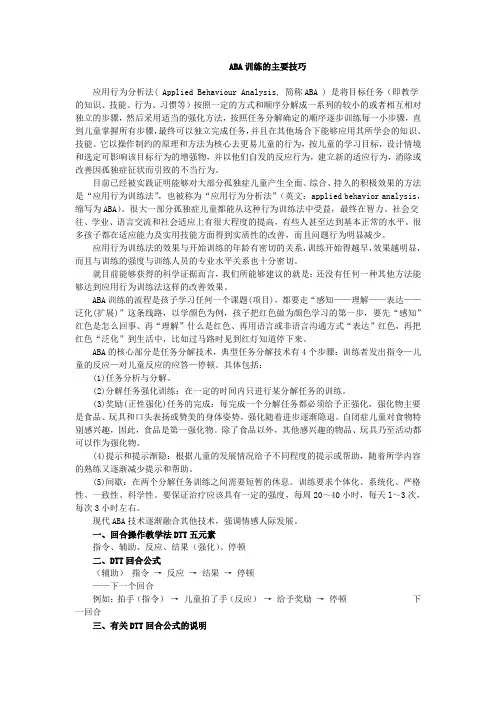
ABA训练的主要技巧应用行为分析法( Applied Behaviour Analysis, 简称ABA ) 是将目标任务(即教学的知识、技能、行为、习惯等)按照一定的方式和顺序分解成一系列的较小的或者相互相对独立的步骤,然后采用适当的强化方法,按照任务分解确定的顺序逐步训练每一小步骤,直到儿童掌握所有步骤,最终可以独立完成任务,并且在其他场合下能够应用其所学会的知识、技能。
它以操作制约的原理和方法为核心去更易儿童的行为,按儿童的学习目标,设计情境和选定可影响该目标行为的增强物,并以他们自发的反应行为,建立新的适应行为,消除或改善因孤独症征状而引致的不当行为。
目前已经被实践证明能够对大部分孤独症儿童产生全面、综合、持久的积极效果的方法是“应用行为训练法”,也被称为“应用行为分析法”(英文:applied behavior analysis,缩写为ABA)。
很大一部分孤独症儿童都能从这种行为训练法中受益,最终在智力、社会交往、学业、语言交流和社会适应上有很大程度的提高,有些人甚至达到基本正常的水平。
很多孩子都在适应能力及实用技能方面得到实质性的改善,而且问题行为明显减少。
应用行为训练法的效果与开始训练的年龄有密切的关系,训练开始得越早,效果越明显,而且与训练的强度与训练人员的专业水平关系也十分密切。
就目前能够获得的科学证据而言,我们所能够建议的就是:还没有任何一种其他方法能够达到应用行为训练法这样的改善效果。
ABA训练的流程是孩子学习任何一个课题(项目),都要走“感知——理解——表达——泛化(扩展)”这条线路,以学颜色为例,孩子把红色做为颜色学习的第一步,要先“感知”红色是怎么回事、再“理解”什么是红色、再用语言或非语言沟通方式“表达”红色,再把红色“泛化”到生活中,比如过马路时见到红灯知道停下来。
ABA的核心部分是任务分解技术,典型任务分解技术有4个步骤:训练者发出指令—儿童的反应—对儿童反应的应答—停顿。
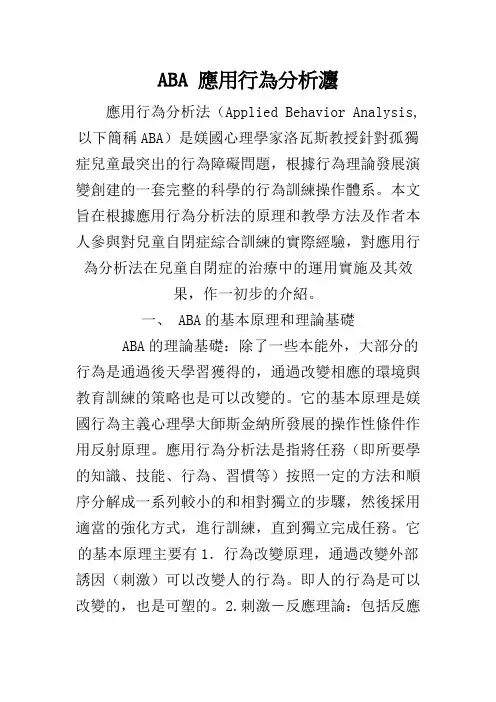
ABA 應用行為分析灋應用行為分析法(Applied Behavior Analysis,以下簡稱ABA)是媄國心理學家洛瓦斯教授針對孤獨症兒童最突出的行為障礙問題,根據行為理論發展演變創建的一套完整的科學的行為訓練操作體系。
本文旨在根據應用行為分析法的原理和教學方法及作者本人參與對兒童自閉症綜合訓練的實際經驗,對應用行為分析法在兒童自閉症的治療中的運用實施及其效果,作一初步的介紹。
一、 ABA的基本原理和理論基礎ABA的理論基礎:除了一些本能外,大部分的行為是通過後天學習獲得的,通過改變相應的環境與教育訓練的策略也是可以改變的。
它的基本原理是媄國行為主義心理學大師斯金納所發展的操作性條件作用反射原理。
應用行為分析法是指將任務(即所要學的知識、技能、行為、習慣等)按照一定的方法和順序分解成一系列較小的和相對獨立的步驟,然後採用適當的強化方式,進行訓練,直到獨立完成任務。
它的基本原理主要有1.行為改變原理,通過改變外部誘因(刺激)可以改變人的行為。
即人的行為是可以改變的,也是可塑的。
2.刺激-反應理論:包括反應性條件反射論,在行為訓練(學習)中,進行強化刺激的做法會產生條件反射。
3.操作性條件反射論,一個人的行為並非單純是刺激的反應,往往行為是根據他人的反應,而加強他是否去發展此行為。
二、ABA的指導思想1、干預的地點最好是兒童自然生活的地方。
孤獨症兒童的教育治療應有一定的條件和結構,但這些條件和結構應盡可能與自然環境接近。
2、干預的重點應從治療轉為教育。
目前沒有有效的醫療手段可對這些障礙本身進行有效治療,相反,如使用恰當的教育方法進行早期干預,能提高兒童的各方面功能。
3、教育和干預的主要執行者是家長和老師,每一個與孤獨症兒童接觸的大人最好都熟悉和使用所推薦的教育方法,以便於學習的行為在其他環境下也能運用。
4、診斷是為了實施干預。
干預人員要將診斷性名稱分解為具體的、易於干預的行為單元,如語言狀況、自理能力和社交技能等。
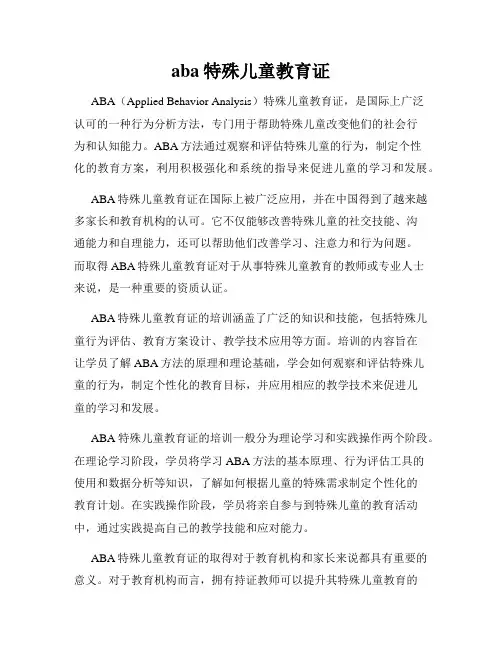
aba特殊儿童教育证ABA(Applied Behavior Analysis)特殊儿童教育证,是国际上广泛认可的一种行为分析方法,专门用于帮助特殊儿童改变他们的社会行为和认知能力。
ABA方法通过观察和评估特殊儿童的行为,制定个性化的教育方案,利用积极强化和系统的指导来促进儿童的学习和发展。
ABA特殊儿童教育证在国际上被广泛应用,并在中国得到了越来越多家长和教育机构的认可。
它不仅能够改善特殊儿童的社交技能、沟通能力和自理能力,还可以帮助他们改善学习、注意力和行为问题。
而取得ABA特殊儿童教育证对于从事特殊儿童教育的教师或专业人士来说,是一种重要的资质认证。
ABA特殊儿童教育证的培训涵盖了广泛的知识和技能,包括特殊儿童行为评估、教育方案设计、教学技术应用等方面。
培训的内容旨在让学员了解ABA方法的原理和理论基础,学会如何观察和评估特殊儿童的行为,制定个性化的教育目标,并应用相应的教学技术来促进儿童的学习和发展。
ABA特殊儿童教育证的培训一般分为理论学习和实践操作两个阶段。
在理论学习阶段,学员将学习ABA方法的基本原理、行为评估工具的使用和数据分析等知识,了解如何根据儿童的特殊需求制定个性化的教育计划。
在实践操作阶段,学员将亲自参与到特殊儿童的教育活动中,通过实践提高自己的教学技能和应对能力。
ABA特殊儿童教育证的取得对于教育机构和家长来说都具有重要的意义。
对于教育机构而言,拥有持证教师可以提升其特殊儿童教育的专业水平和服务质量,吸引更多家长的信任和选择。
对于家长而言,拥有持证教师的指导可以帮助他们更好地了解和引导孩子的行为,促进孩子的成长和发展。
总结而言,ABA特殊儿童教育证是一种国际上广泛认可的教育证书,专门用于帮助特殊儿童改善社会行为和认知能力。
取得这个证书的教师或专业人士将具备专业的知识和技能,可以提供更专业和个性化的教育服务。
同时,对于教育机构和家长来说,持有ABA特殊儿童教育证的教师将更有竞争力和可信度,受到更多人的认可和信赖。
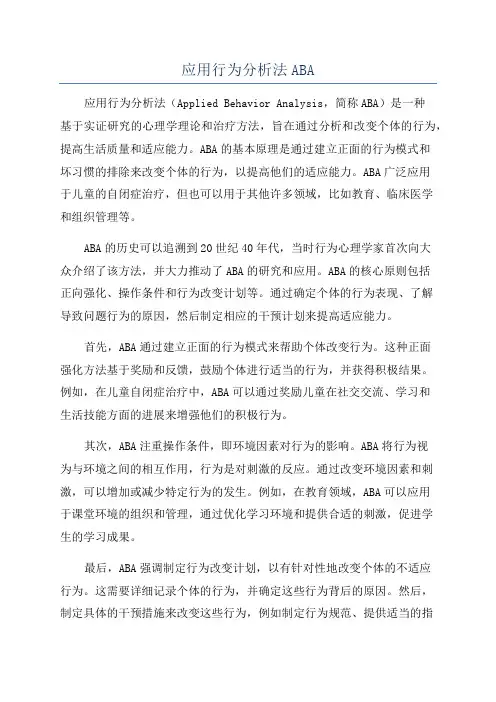
应用行为分析法ABA应用行为分析法(Applied Behavior Analysis,简称ABA)是一种基于实证研究的心理学理论和治疗方法,旨在通过分析和改变个体的行为,提高生活质量和适应能力。
ABA的基本原理是通过建立正面的行为模式和坏习惯的排除来改变个体的行为,以提高他们的适应能力。
ABA广泛应用于儿童的自闭症治疗,但也可以用于其他许多领域,比如教育、临床医学和组织管理等。
ABA的历史可以追溯到20世纪40年代,当时行为心理学家首次向大众介绍了该方法,并大力推动了ABA的研究和应用。
ABA的核心原则包括正向强化、操作条件和行为改变计划等。
通过确定个体的行为表现、了解导致问题行为的原因,然后制定相应的干预计划来提高适应能力。
首先,ABA通过建立正面的行为模式来帮助个体改变行为。
这种正面强化方法基于奖励和反馈,鼓励个体进行适当的行为,并获得积极结果。
例如,在儿童自闭症治疗中,ABA可以通过奖励儿童在社交交流、学习和生活技能方面的进展来增强他们的积极行为。
其次,ABA注重操作条件,即环境因素对行为的影响。
ABA将行为视为与环境之间的相互作用,行为是对刺激的反应。
通过改变环境因素和刺激,可以增加或减少特定行为的发生。
例如,在教育领域,ABA可以应用于课堂环境的组织和管理,通过优化学习环境和提供合适的刺激,促进学生的学习成果。
最后,ABA强调制定行为改变计划,以有针对性地改变个体的不适应行为。
这需要详细记录个体的行为,并确定这些行为背后的原因。
然后,制定具体的干预措施来改变这些行为,例如制定行为规范、提供适当的指导和支持等。
这种定制化的干预计划可以根据个体的需求和能力进行调整,从而达到有效的干预效果。
尽管ABA最初主要用于自闭症儿童的治疗,但现在被广泛应用于其他领域。
教育方面,ABA可以帮助学生提高学习技能、社交交流和自我管理等方面的能力。
临床医学方面,ABA可以用于治疗精神疾病、成瘾问题和行为障碍等。
ABA应用行为分析的原理什么是ABA应用行为分析?ABA(Applied Behavior Analysis)是一种基于行为主义理论的心理学方法,它通过观察和分析个体行为,以及对环境因素的干预来改变人们的行为。
ABA应用行为分析广泛应用于儿童教育、自闭症治疗、组织管理等领域。
ABA应用行为分析的原理ABA应用行为分析的实践基于以下几个核心原理:1.行为是可改变的ABA应用行为分析的核心观点是,人类和动物的行为都可以通过适当的方法和干预来改变。
行为不仅受遗传因素和生理特点的影响,还受到环境因素的影响。
因此,通过调整环境因素,可以改变个体的行为。
2.行为是有意义的ABA应用行为分析认为,行为是个体对环境的反应,具有一定的意义和目的。
行为可以通过观察和分析,了解个体的需求和动机,并通过针对性的干预来满足这些需求或改变个体的动机。
3.行为是可测量的ABA应用行为分析注重行为的客观测量和数据分析。
通过详细记录和分析个体的行为,可以了解行为的频率、持续时间、强度等特征,并据此制定合理的干预计划和评估进展。
4.行为是可预测的ABA应用行为分析认为,人类和动物的行为具有一定的规律性和可预测性。
通过观察个体的行为模式,可以预测其未来的行为,并根据这些预测制定相应的干预策略。
5.行为是可控制的ABA应用行为分析强调通过干预个体的环境,可以改变其行为。
环境因素包括物质和社会环境,通过调整这些因素,可以控制和改变个体的行为。
ABA应用行为分析的干预方法ABA应用行为分析根据个体的具体需求和目标,采用多种干预方法来改变行为。
以下列举了一些常见的干预方法:•正向增强:通过提供积极的奖励或赞扬,来增加一个特定行为的频率。
例如,儿童完成作业后给予奖励,以增加其完成作业的积极行为。
•负向增强:通过减小或去除不愉快的刺激,来增加一个特定行为的频率。
例如,在学习情境下,教师去除讨厌的噪音,以增加学生专注学习的行为。
•惩罚:通过引入或增加一个不愉快的刺激,来减少一个特定行为的频率。
应用行为分析法应用行为分析法( Applied Behaviour Analysis, 简称ABA ) 是将目标任务(即教学的知识、技能、行为、习惯等)按照一定的方式和顺序分解成一系列的较小的或者相互相对独立的步骤,然后采用适当的强化方法,按照任务分解确定的顺序逐步训练每一小步骤,直到儿童掌握所有步骤,最终可以独立完成任务,并且在其他场合下能够应用其所学会的知识、技能。
它以操作制约的原理和方法为核心去更易儿童的行为,按儿童的学习目标,设计情境和选定可影响该目标行为的增强物,并以他们自发的反应行为,建立新的适应行为,消除或改善因孤独症征状而引致的不当行为。
1.情境设计 开始训练时,需要找一个视觉和听觉刺激很少的、相对固定的环境。
比如,一对一的个别训练室,在那儿放一个小桌子和两个小椅子(椅子的高度必须以能相互对视为准),地上舖有地毯;房间布置要尽量简单,以暗色调为主,但光线要充足,周围不要有可以吸引儿童注意力的物品,甚至连墙壁也只要白墙即可,条件允许的话可在墙壁的适当位置安装能做观察用的单向透视镜;教学中可以根据需要增加指导者从旁协助教学;根据课程设计需要,室内可置必要之教材教具。
2.指导课题 依据个别的教育治疗目标,一次进行一个孤独症儿童行为治疗目标。
3.指导方式 ① 一对一的个别训练 一对一教学,这是主要形式,适用于参与能力、模仿、语言、认知和精细动作等项目的训练,生活自理、听一步指令、粗大动作等项目。
训练时一定要选准可以影响儿童行为能力发展的增强物;随着儿童在一对一的个别训练中行为的获得和儿童能力的发展状况,逐步将儿童带入小组或团体中做泛化指导,使得个别指导中所习得的行为得以在团体或生活实际中发展。
② 以活动为基础的教学,这适用于教儿童同他人游戏、交往、语言理解和语言表达等项目。
③ 偶发事件中的教学,在生活(家庭、社会等)中,尤其是社会交往、社会适应等活动,抓住机会促使儿童运用已会的知识、技能和展示已养成的行为、习惯;抓住机会自然地教给儿童知识、技能、培养儿童良好的行为、习惯。
行为分析法简介应用行为分析法自从1993年以来在美国越来越广泛地受到教育界的注意。
在莫莉思1993年写的《让我听你的声音》书中,讲了一个有两个孤独症孩子家庭,矫治孩子的方法。
他们看了罗瓦思1987写的一篇文章后决定按照他的方法建立家里的强化训练项目。
他们的结果显得十分成功。
因此现在美国很多家长和专家都在讨论这个教法。
罗瓦思在1981年的书阐明了他的方法。
孩子的训练一般是在他三岁半前开始的。
每周在家里有三十到四十个小时的训练。
就是每星期5—7天的训练,每天4—6个小时(都是一对一的)。
这种时间安排不是绝对的,主要是要按照各各儿童的需要调整。
一次训练平均2—3个小时(包括休息)。
每个项目(5分钟左右)结束之后要休息1—2分钟,每小时也让儿童休息15分钟,那时候他可以自己玩,吃零食,看录象,等活动。
开展一个应用性行为分析法(ABA)训练计划需要哪些人参与?在美国一般来说要组成一个“治疗组”。
这组有至少三个人,这样可以保障他们一周的工作的时间加起来可达到30—40小时。
通常参与的人员是学教育学或心理学的大学生或研究生,但有时也可以请亲戚来帮助。
如果这些人愿意作志愿者当然最好,但是常常找到的是要打工的学生。
家长也是这个组的成员,但是不一定是直接来充当一对一的教师。
也可能,家长自己先学会这种操作技能,再教给请来的老师,他的角色是参加每周治疗组开会。
最好是,能先请专家来,一起设置一些合适的项目,帮所有训练人员(家长和其他老师)都掌握同样的方法。
如果没有这种专家,家长可以自己通过看了书,了解了方法以后,就开始做。
一个人只要有兴趣,有积极性和能够坚持就可以学会这个方法。
这几年来在美国越来越多学校,机构和家庭都选用应用行为分析法(AppliedBehaviorAnalysis,ABA)来教孤独症儿童。
教学、训练的方式叫回合式教学(DiscreteTrialTeaching)。
这种DTT是一种具体的训练技术。
它主要具有以下特点:①将每一项要教的技能(skill)分成小的步骤,然后一步步地练习;②强化性(intensive)教学,反复训练每个步骤;③使用提示帮助孩子做出正确的反应;④使用强化物及强化手段。
专题一应用行为分析(ABA)【主要内容】✧ABA的基本知识:名称与历史起源;理论基础与原理;基本思想与原则;课程与实施要求✧ABA的重要前提:行为评估与分析✧ABA的基本原则:目标行为分析/分解✧ABA的操作方法:分解式尝试教学法(DTT);关键性技能训练法(PRT)✧ABA的三大策略:强化策略;刺激控制策略;厌恶控制策略✧ABA的主要应用:适应行为的培养;问题行为的解决✧ABA的发展趋势:言语-语言治疗与ABA相结合ABA的基本知识.名称与历史起源.理论基础与原理.基本思想与特点.课程与实施要求名称与历史起源应用行为分析法(Applied Behavior Analysis,简称ABA),也称“行为训练法”、“行为改变技术”等。
“行为分析”是研究行为、行为的变化及影响因素的一门科学;“应用行为分析”是将行为分析所得的结果进行应用,以达到理解行为和环境之间功能性关系的科学。
⏹Applied—应用✓学校(学业学习/功能性学习/职业训练/人际互动/班级管理)✓家庭(生活训练/家事学习/亲子互动/教养方式/休闲娱乐)✓社会(社交活动/职场适应/社会规范)✓医疗(行为/药物/心理)⏹Behavior—行为✓所有面向(社会/认知/情绪/语言/游戏/心智/动作技能)✓可观察、可度量、具体的(三者缺一不可/行为目标的基础)✓排除主观价值判断(教育公平/个别化教育)⏹Analysis—分析(科学、验证、系统化)ABA作为一种干预模式,于20世纪60年代由美国加州大学洛杉矶分校的心理学教授伊瓦·洛瓦斯(Ivar Lovaas)针对自闭症最突出的行为障碍问题,基于传统的行为主义学习理论和操作条件作用而发展演变出的一套较为完整的行为训练技术和操作系统。
Lovaas博士及助手于1987年和1993年发表了两个追踪研究,结果表明ABA早期治疗能显著改善自闭症儿童的功能。
19个接受密集行为治疗的孩子,有9个能成功地完成常规教育课程,并在智力测验、适应技能和情绪功能方面,看不出他们和同伴有什么差别。
自闭症训练之应用行为分析疗法1964年,Lovaas开始倡导应用行为分析疗法。
经过多年的尝试,行为改变技术的确对自闭儿提升功能有效果,而应用行为分析(Applied Behavior Analysis, ABA)的教导模式则对行为改变技术做了更有效的改进,最主要的是不使用嫌恶物的刺激以及将教导场所由诊间转到家庭及学校。
一、应用行为分析的要项应用行为分析是一种必须以行为为基础(Performance Based),并以分析为主,由专业人员进行分析的行为分析模式。
施行活动的目标及内容对个案必须有重要社会性,并和个案已发生的情境或可能发生的情境相关联。
在设计的过程中必须要确认其行为是可以被说明的而非只能做单纯的观察及描述。
二、功能分析模式藉由观察前因、行为、结果三者之间的关系来分析行为的方法,且用于教导技能,分析目标行为及问题行为。
Antecedent(前因):包括了活动、时间、地点、人物及物件;Behavior(行为):包括了可观察的、可测量的及具体的;Consequence(结果):包括了增强、惩罚及消除等。
三、奖赏及贿赂在前因、行为及结果的功能分析下,一些方法的介入会改变行为发生的特性,其中以增强法最为重要,但一般大众常把增强法及贿赂混淆,造成个案不当的行为反应持续的发生,因此如果能充分的了解行为增强法,对自闭儿的行为教导及治疗策略的拟定上必定有很大的助益。
四、增强物的使用增强法被用来增加或维持行为的发生率。
而增强物的类别包括以下几种:实物:包括任何可收集或拥有的东西(杂志,玩具车,珠宝及棒球卡等);可食用的:食物、饮料等;活动:看电视、玩游戏、买东西等;代币,一种可交换增强物的做法。
五、如何有效运用增强原理Appropriate:针对个案适当的年龄、适当的情况下施行不同类型的行为治疗法,避免太过或不足。
Contingent:针对目标行为的,马上在给出正确行为后增强而不延迟出现。
Consistent:针对相同的行为反应及结果给予一致的增强,避免不同方式的行为增强和不定时增强。
ABA训练计划介绍应用行为分析法(Applied Behavior Analysis, ABA)自从1993年以来在美国越来越广泛地受到教育界的注意。
在莫莉思1993年写的《让我听你的声音》书中,讲了一个有两个孤独症孩子家庭,矫治孩子的方法。
他们看了罗瓦思1987写的一篇文章后决定按照他的方法建立家里的强化训练项目。
他们的结果显得十分成功。
因此现在美国很多家长和专家都在讨论这个教法。
这几年来在美国越来越多学校,机构和家庭都选用ABA训练计划来教孤独症儿童。
具体内容罗瓦思在1981年的书阐明了他的方法。
孩子的训练一般是在他三岁半前开始的。
每周在家里有三十到四十个小时的训练。
就是每星期5—7天的训练,每天4—6个小时(都是一对一的)。
这种时间安排不是绝对的,主要是要按照各各儿童的需要调整。
一次训练平均2—3个小时(包括休息)。
每个项目(5分钟左右)结束之后要休息1—2分钟,每小时也让儿童休息15分钟,那时候他可以自己玩,吃零食,看录象,等活动。
参与人员开展一个应用行为分析法(ABA)训练计划需要哪些人参与在美国一般来说要组成一个“治疗组”。
这组有至少三个人,这样可以保障他们一周的工作的时间加起来可达到30—40小时。
通常参与的人员是学教育学或心理学的大学生或研究生,但有时也可以请亲戚来帮助。
如果这些人愿意作志愿者当然最好,但是常常找到的是要打工的学生。
家长也是这个组的成员,但是不一定是直接来充当一对一的教师。
也可能,家长自己先学会这种操作技能,再教给请来的老师,他的角色是参加每周治疗组开会。
最好是,能先请专家来,一起设置一些合适的项目,帮所有训练人员(家长和其他老师)都掌握同样的方法。
如果没有这种专家,家长可以自己通过看了书,了解了方法以后,就开始做。
一个人只要有兴趣,有积极性和能够坚持就可以学会这个方法。
技术特点教学、训练的方式叫回合式教学(Discrete Trial Teaching)。
这种DTT 是一种具体的训练技术。